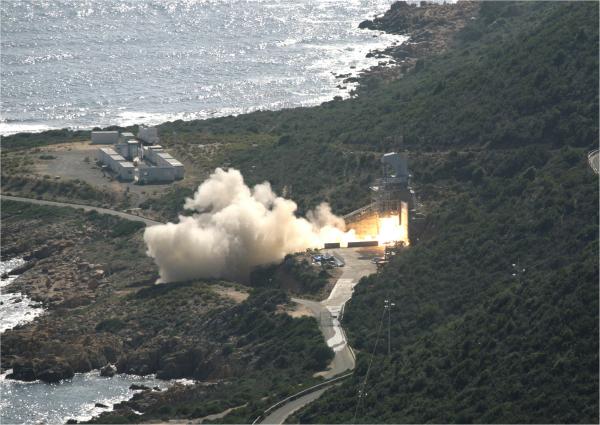The Zefiro 9-A (Z9-A) solid-fuel rocket motor, which will power the Vega launch vehicle’s third stage, left the production facility of Avio, in Colleferro (Italy), at the end of September and was installed at the test site over the last three weeks.
After a nominal 120-second burn time, during which a maximum combustion pressure of 75 bar was reached, the roar of the motor stopped as expected. The first results confirm the expected performance increase for this enhanced version of the motor, as well as the robustness of the modifications introduced in the nozzle design.

On 23 October, the Zefiro 9-A motor successfully completed its first firing test at the Salto di Quirra Inter-force Test Range in Sardinia (Italy). The Vega launcher’s qualification flight is scheduled to take place by the end of 2009. After a nominal 120-second burn time, during which a maximum combustion pressure of 75 bar was reached, the roar of the motor stopped as expected. The first results confirm the expected performance increase for this enhanced version of the motor, as well as the robustness of the modifications introduced in the nozzle design. Credits: Avio SpA (Italy)
The Zefiro 9-A motor, with an overall height of 3.17 m and a diameter of 1.92 m, contains 10.5 tonnes of propellant and provides a maximum thrust of 320 kN (about 32.6 tonnes-force), in vacuum. The Z9-A has the highest propellant-mass to inert-mass ratio of any space-transportation solid-propellant rocket motor ever fired.
Some 400 sensors fitted to the motor allowed monitoring of its behaviour during and after the firing test. The data collected will enable engineers from ELV SpA (Italy), the Vega launch vehicle prime contractor, and Avio SpA (Italy), in charge of the motor development and qualification, to check its performance, in particular:
- ballistic performance (pressure and thrust curves)
- internal thermal-protection efficiency
- thrust-vector control performance
- induced thermal and dynamic environment
Towards flight qualification
A second qualification test for the Zefiro 9-A is planned for February 2009. This will complete the qualification process of the Vega solid rocket motors. The P80 first-stage motor and the Z23 second-stage motor, both of which also use solid propellant, have already completed successful qualification firing tests.
The Vega launcher qualification flight is scheduled to take place before the end of 2009, from Europe’s spaceport at Kourou, in French Guiana.
Vega is a single-body launcher composed of three solid-propellant stages and a liquid-propellant upper module. It is approximately 30 m high, and weighs a total of 137 tonnes at lift-off. The reference mission for Vega’s launch capacity is to carry 1500 kg into a 700km-altitude polar orbit, but Vega will be able to launch a wide range of scientific and Earth-observation missions.






Comments